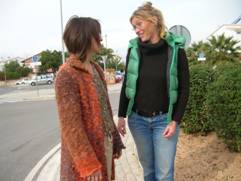
The society we have found ourselves in, the society of knowledge, is characterized, among other things, by the fact that us citizens need to learn all along our lives. A society defined by permanent change requires its citizens to learn permanently. In this sense, learning and teaching are key social activities.
Apart from learning from an expert (teacher, peer…) an important source of learning comes from interactions with others who are near us (with whom we share a same situation of status and who do not function as a professional teacher in that relationship). This is what we call peer learning, be it among students, among colleagues of a same profession, among members of a same family…
Peer learning can be formal (within the structure of an educational or professional system as, for example, the use of cooperative learning in the classroom) or informal (outside that structure and of a voluntary nature).
In this field, learning the host language, is especially interesting Voluntariat per la llengua (Volunteers for the language), the programme promoted by the General Directorate of language policy (DGPL) of the Catalan Government. Voluntariat per llengua (VxL) is a programme for practicing Catalan through conversation. It is based on the creation of language pairs, organized in peer tutoring, formed by a tutor (called volunteer), who is fluent in Catalan, and a tutee (called learner) that has basic language knowledge and wants to acquire fluency to speak it. The programme was born in 2003 and more than 100,000 pairs have passed by it. The European Commission recognized him (2005) as one of the 50 best practices of learning of a language that is underway in the European Union.
Among the materials published to give support to the participants of the programme, in 2014 the DGPL published Llegir per parlar, llegir per aprendre (Read to talk, read to learn) in order to strengthen the learning and use of the language through reading. The focus of these materials responds fully to the methodology that we have driven from the GRAI through Reading in pairs programme (as it is recognized in its user guide). Llegir per parlar, llegir per aprendre consists of a set of activity sheets, which combine a reading with the practice of the conversation; and a guide to use of materials containing the teaching guidelines. The proposed activities always involved a tutor (who is who leads the activities and takes responsibility for the preparation of the reading before the meeting) and an apprentice.
The material can be downloaded from the website http://llengua.gencat.cat/ca/serveis/informacio_i_difusio/publicacions_en_linia/llegir_per_parlar
The development of Internet has enhanced the opportunities of peer learning. From the discussion lists, chats, forums… where knowledge can be shared and constructed with others, to other everyday more sophisticated and effective uses such as Communities of Practice, based on P2P (peer to peer), where equals from a same professional area learn by helping others improve their professional competences (Blunt, 2003).
Referències
Blunt, R. (2003). Communities at the Speed of Business. Communities of Practice as Peer-to-Peer Learning Networks. New York: iUniverse, Inc.
Casas, M. i Danés, A. (2004). Tots els colors de la llengua. Vic: Edicions de l’Àlber.
Gobierno Vasco (2004). Orientaciones para la elaboración del plan de acogida de alumnado inmigrante. Gasteiz: Servicio central de prublicaciones del Gobierno Vasco.
Sanz, V., Nadal, M., Sanz, S., i Gallego, A. (2014). Voluntariat per la llengua: Una història que va començar fa 10 anys. Llengua i Ús, 54. https://raco.cat/index.php/LlenguaUs/article/view/279221/366946